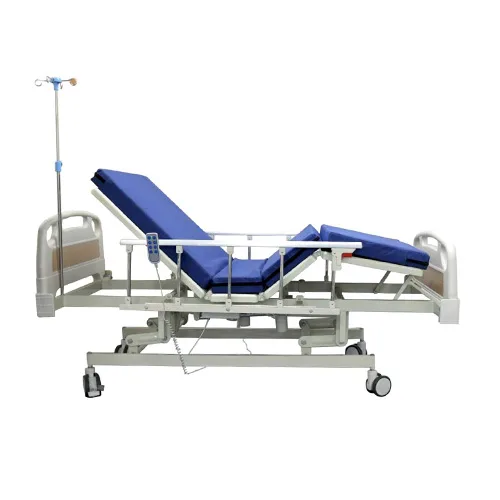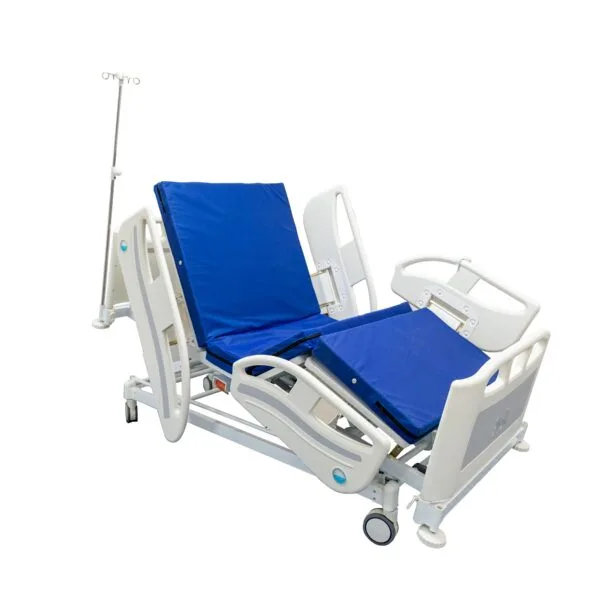Endereço
304 North Cardinal St.
Dorchester Center, MA 02124
Horas de trabalho
Segunda a sexta: 7h00 - 19h00
Fim de semana: 10h - 17h
Endereço
304 North Cardinal St.
Dorchester Center, MA 02124
Horas de trabalho
Segunda a sexta: 7h00 - 19h00
Fim de semana: 10h - 17h

As dimensões padrão das camas hospitalares desempenham um papel fundamental na acomodação de pacientes, no suporte a procedimentos médicos e na otimização das operações das instalações.
Bem-vindo ao meu blog!
Antes de mergulharmos no conteúdo, adoraria que você se juntasse a mim nas minhas plataformas de mídia social, onde compartilho mais insights, interajo com a comunidade e posto atualizações. Veja como você pode se conectar comigo:
Facebook:https://www.facebook.com/profile.php?id=100071234835011
LinkedIn:https://www.linkedin.com/company/74943205/admin/dashboard/
YouTube:www.youtube.com/@shandongexpertmedicalequip4695
TikTok:www.tiktok.com/@expertmedical
Agora, vamos começar nossa jornada juntos. Espero que você ache o conteúdo aqui perspicaz, envolvente e valioso.

Hospitais e instalações de saúde em todo o mundo dependem de equipamentos projetados para atender a padrões específicos, garantindo a segurança, o conforto e a eficiência na prestação de cuidados aos pacientes. Entre eles, as dimensões padrão das camas hospitalares desempenham um papel fundamental na acomodação dos pacientes, no suporte a procedimentos médicos e na otimização das operações das instalações. Na Expert, uma empresa de alta tecnologia especializada em pesquisa, desenvolvimento e distribuição global de equipamentos para salas de cirurgia (SO) e unidades de terapia intensiva (UTI), entendemos a importância de respeitar essas dimensões para atender às diversas necessidades de saúde. Este guia abrangente explora as complexidades das dimensões padrão das camas hospitalares, suas variações e sua importância nos ambientes modernos de saúde.
As dimensões das camas hospitalares não são arbitrárias; elas são cuidadosamente projetadas para equilibrar o conforto do paciente, a acessibilidade do cuidador e a eficiência espacial. Seja para enfermarias gerais, UTIs ou unidades especializadas, compreender as dimensões padrão das camas hospitalares ajuda os profissionais de saúde a tomar decisões informadas ao equipar suas instalações. Este blog abordará aspectos importantes, incluindo tipos de cama, padrões regionais e considerações práticas, garantindo que você tenha uma compreensão completa deste tópico essencial.
As dimensões padronizadas de camas hospitalares são cruciais por vários motivos. Primeiro, elas garantem a compatibilidade com acessórios médicos, como colchões, grades laterais e elevadores de pacientes, projetados para se adaptarem a tamanhos específicos de cama. Segundo, as dimensões padronizadas facilitam o uso eficiente do espaço em instalações de saúde, permitindo a otimização do layout dos quartos e do fluxo de pacientes. Por fim, a adesão às dimensões padronizadas de camas hospitalares garante a conformidade com as diretrizes regulatórias, que variam de acordo com a região, mas frequentemente impõem requisitos mínimos para a segurança e o cuidado do paciente.
Na Expert, nossos equipamentos para salas de cirurgia e UTI, incluindo camas hospitalares, são projetados para atender a esses padrões globais, garantindo integração perfeita em ambientes de saúde em todo o mundo. Ao priorizar dimensões padrão de camas hospitalares, ajudamos os hospitais a oferecer atendimento de alta qualidade, mantendo a eficiência operacional.


Existem vários tipos de camas hospitalares, cada uma adaptada às necessidades médicas específicas. Compreender as dimensões padrão de cada tipo de cama hospitalar é essencial para selecionar o equipamento certo. A seguir, exploramos os tipos mais comuns e suas dimensões típicas.
As camas de enfermaria geral são o tipo mais comum encontrado em hospitais. Essas camas geralmente medem 91 cm de largura por 203 cm de comprimento, com altura ajustável entre 38 e 76 cm. Essas dimensões padrão de camas hospitalares acomodam a maioria dos pacientes adultos e permitem que os cuidadores ajustem a cama para maior conforto e acessibilidade.
Os leitos de UTI são projetados para pacientes graves que necessitam de monitoramento e suporte intensivos. Esses leitos costumam ser um pouco maiores, com dimensões padrão de 97 a 107 cm de largura por 203 a 213 cm de comprimento (97 a 107 cm x 203 a 213 cm). A largura extra acomoda dispositivos médicos, enquanto o comprimento suporta pacientes mais altos ou equipamentos adicionais.
As camas hospitalares pediátricas são menores para atender às crianças, com dimensões padrão que variam de 76 a 91 cm de largura por 152 a 190 cm de comprimento. Essas dimensões garantem um ambiente seguro e confortável para pacientes jovens, além de facilitar o acesso dos cuidadores.
As camas bariátricas são projetadas para pacientes com maior capacidade de peso, frequentemente excedendo 272 kg. Essas camas têm dimensões padrão de cama hospitalar de 107 a 137 cm de largura por 203 a 224 cm de comprimento, proporcionando amplo espaço e suporte estrutural.
As dimensões padrão de camas hospitalares podem variar de acordo com a região devido a diferenças nas regulamentações de saúde, na demografia dos pacientes e no design das instalações. Abaixo, descrevemos os principais padrões regionais.
Nos Estados Unidos e no Canadá, as dimensões padrão de camas hospitalares para adultos geralmente seguem o modelo de 91 x 203 cm (36 x 80 polegadas) para enfermarias gerais. As camas de UTI e bariátricas podem ser mais largas e mais compridas, como observado anteriormente, para atender às diversas necessidades dos pacientes.
As normas europeias, orientadas por organizações como o Comitê Europeu de Normalização (CEN), frequentemente especificam dimensões ligeiramente diferentes. Por exemplo, camas de enfermaria geral podem medir de 90 a 100 cm de largura por 200 a 210 cm de comprimento (35 a 39 polegadas x 79 a 83 polegadas). Essas variações refletem as preferências regionais quanto aos tamanhos de colchões e às configurações dos quartos.
Na Ásia, as dimensões padrão de camas hospitalares podem ser ligeiramente menores para se adequar a tamanhos de quartos e populações de pacientes menores. As camas de enfermaria geralmente medem de 85 a 90 cm de largura por 190 a 200 cm de comprimento (33 a 35 polegadas x 75 a 79 polegadas). No entanto, fabricantes globais como a Expert garantem a compatibilidade com os padrões internacionais para os mercados de exportação.
Para fornecer uma visão geral clara, a tabela abaixo resume as dimensões padrão de camas hospitalares para diversos tipos de cama. Esta referência pode auxiliar os profissionais de saúde na seleção da cama adequada para suas instalações.
| Tipo de cama | Largura (polegadas/cm) | Comprimento (polegadas/cm) | Faixa de altura (polegadas/cm) | Capacidade de peso (lbs/kg) |
|---|---|---|---|---|
| Ala Geral | 36 / 91 | 80 / 203 | 15–30 / 38–76 | 400–500 / 181–227 |
| UTI | 38–42 / 97–107 | 80–84 / 203–213 | 15–32 / 38–81 | 500–600 / 227–272 |
| Pediátrico | 30–36 / 76–91 | 60–75 / 152–190 | 12–28 / 30–71 | 200–350 / 91–159 |
| Bariátrico | 42–54 / 107–137 | 80–88 / 203–224 | 15–32 / 38–81 | 600–1000 / 272–454 |
Esta tabela reflete as dimensões típicas de camas hospitalares padrão e pode variar ligeiramente dependendo do fabricante ou região. Na Expert, nossas camas hospitalares são projetadas para atender a esses padrões, oferecendo opções personalizáveis para necessidades específicas.
Além das medidas básicas, diversos recursos influenciam as dimensões padrão de camas hospitalares e sua funcionalidade. Entre eles, estão a capacidade de ajuste, as grades laterais e a tecnologia integrada.
A maioria das camas hospitalares possui ajustes de altura, cabeceira e peseira. Esses ajustes podem afetar as dimensões efetivas, principalmente quando a cama é elevada ou inclinada. As dimensões padrão das camas hospitalares levam em conta essas variações para garantir a compatibilidade com os layouts dos quartos e os equipamentos médicos.
Grades laterais, um recurso comum, aumentam a largura total da cama. Embora a largura do colchão permaneça dentro das dimensões padrão de uma cama hospitalar, a largura total, incluindo grades, pode aumentar de 10 a 15 cm. Esta é uma consideração crucial para o planejamento do quarto.
Camas hospitalares modernas geralmente incluem balanças, monitores ou painéis de controle integrados, que podem alterar ligeiramente as dimensões padrão das camas hospitalares. Na Expert, incorporamos esses recursos sem comprometer a conformidade com os padrões globais, garantindo que nossas camas atendam aos requisitos funcionais e regulatórios.
Ao selecionar leitos hospitalares, as unidades de saúde devem considerar fatores que vão além das dimensões padrão de leitos hospitalares, como a população de pacientes, o tamanho do quarto e as restrições orçamentárias.
Instalações que atendem populações diversas, como pacientes pediátricos ou bariátricos, devem priorizar leitos com dimensões hospitalares padrão adequadas. Por exemplo, um hospital com alto volume de pacientes bariátricos pode investir em leitos mais largos para garantir conforto e segurança.
As dimensões dos quartos de hospital determinam o número e o tamanho das camas que podem ser acomodadas. As dimensões padrão das camas hospitalares são projetadas para se adequar aos layouts típicos dos quartos, mas instituições com espaços menores podem optar por camas mais estreitas ou designs dobráveis.
Embora as dimensões padrão de camas hospitalares sejam consistentes, os custos variam de acordo com recursos como ajuste elétrico ou materiais avançados. A Expert oferece uma gama de camas hospitalares que equilibram qualidade, conformidade e preço acessível, garantindo valor a longo prazo para provedores de saúde globais.
Órgãos reguladores em todo o mundo estabelecem diretrizes para dimensões padrão de camas hospitalares para garantir segurança e interoperabilidade. Nos EUA, a Food and Drug Administration (FDA) fornece recomendações, enquanto na Europa, o Regulamento de Dispositivos Médicos (MDR) define os requisitos. Essas normas abrangem não apenas dimensões, mas também capacidade de peso, materiais e recursos de segurança.
Na Expert, nossas camas hospitalares são rigorosamente testadas para atender ou exceder esses padrões regulatórios, garantindo sua adequação aos mercados globais. A conformidade com as dimensões padrão de camas hospitalares é um pilar fundamental do nosso processo de design, refletindo nosso compromisso com a qualidade e o atendimento ao paciente.

O setor da saúde está evoluindo, assim como os designs de camas hospitalares. As tendências emergentes incluem camas modulares que se adaptam às dimensões padrão de camas hospitalares, camas inteligentes com integração de IoT e materiais ecológicos. Essas inovações visam aprimorar os resultados dos pacientes, mantendo a conformidade com os padrões estabelecidos.
A Expert está na vanguarda dessas tendências, incorporando tecnologia avançada e práticas sustentáveis em nossos equipamentos para salas de cirurgia e UTI. Nossas camas hospitalares são projetadas para atender aos padrões atuais de dimensões hospitalares, antecipando as necessidades futuras, tornando-as uma escolha confiável para instalações com visão de futuro.
Entendimento dimensões padrão de cama hospitalar é essencial para equipar as unidades de saúde com as ferramentas certas para oferecer um atendimento excepcional. De leitos de enfermaria geral a modelos especializados de UTI e bariátricos, essas dimensões garantem o conforto do paciente, a eficiência do cuidador e a conformidade regulatória. Ao considerar fatores como tipo de leito, padrões regionais e necessidades práticas, os hospitais podem tomar decisões informadas que aprimoram o sucesso operacional.
Na Expert, estamos comprometidos em fornecer camas hospitalares de alta qualidade que atendam aos padrões globais de dimensões de camas hospitalares, ao mesmo tempo em que incorporam recursos inovadores. Contate-nos hoje para explorar nossa linha de equipamentos de sala de cirurgia e UTI e encontrar a solução perfeita para sua instalação.
Quais são as dimensões padrão de camas hospitalares para enfermarias gerais?
As camas de enfermaria geral medem normalmente 91 cm x 203 cm de largura por 203 cm de comprimento, com alturas ajustáveis entre 38 e 76 cm.
Como funcionam as UTIs dimensões da cama diferem dos leitos de enfermaria geral?
As camas de UTI são um pouco maiores, com dimensões padrão de cama hospitalar de 38 a 42 polegadas de largura por 80 a 84 polegadas de comprimento (97 a 107 cm x 203 a 213 cm), para acomodar equipamentos médicos e pacientes gravemente enfermos.
As dimensões padrão das camas hospitalares são as mesmas no mundo todo?
Não, as dimensões variam de acordo com a região. Por exemplo, camas europeias podem ter de 90 a 100 cm de largura, enquanto camas asiáticas podem ser um pouco menores. No entanto, fabricantes globais como a Expert garantem a compatibilidade com os padrões internacionais.